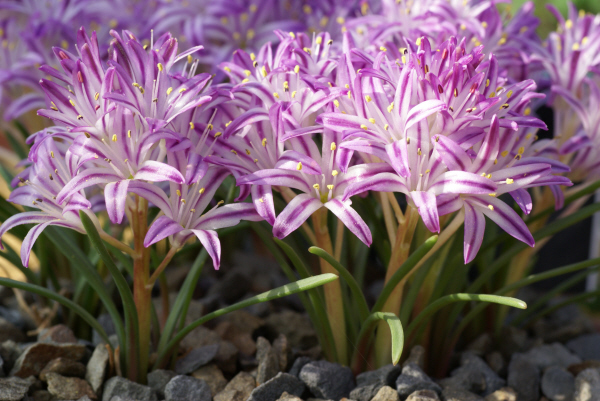Lachenalia corymbosa
corymbous Cape cowslip
A bulbous perennial, up to 15cm high, growing from autumn to spring, with narrow green leaves, up to 150mm long and 5mm wide. In autumn and early winter dense clusters of honey-scented, bell-shaped flowers, about 15mm wide, appear. Flowers are lilac-pink, flushed with a darker blue-lilac central stripe along each petal
Size
Ultimate height
0.1–0.5 metresTime to ultimate height
2–5 yearsUltimate spread
0.1–0.5 metresGrowing conditions
Moisture
Moist but well–drained, Well–drainedpH
Acid, NeutralColour & scent
| Stem | Flower | Foliage | Fruit | |
| Spring | Green | |||
|---|---|---|---|---|
| Summer | ||||
| Autumn | Pink Purple | Green | ||
| Winter | Pink Purple | Green |
Position
- Full sun
Aspect
South–facing or West–facing
Exposure
Sheltered Hardiness
H2Botanical details
- Family
- Asparagaceae
- Native to GB / Ireland
- No
- Foliage
- Deciduous
- Habit
- Clump forming
- Genus
Lachenalia are bulbous perennials with strap-shaped, sometimes dark-spotted leaves, and erect stems bearing racemes or spikes of tubular flowers, slightly fragrant in some species, in autumn, winter or early spring
- Name status
Correct
- Plant range
- South Africa (Cape)
How to grow
Cultivation
Plant bulbs 10cm deep: in frost-prone areas, grow in a cool greenhouse or conservatory in full light in peat-free, loam-based potting compost such as John Innes No. 2, and water moderately as growth starts, water freely when in full growth (adding a balanced fertilizer every fortnight), and reduce watering as the leaves fade, then keep dry until fresh growth starts; in frost-free areas with dry summers, grow in full sun in well-drained soil in a rock garden or among low shrubs
Propagation
Propagate by seed, sown at 13-18°C, as soon as it is ripe, or by division, removing bulblets from dormant plants and repotting or replanting straightaway
Suggested planting locations and garden types
- Patio and container plants
Pruning
Remove old flowering stems as they fade
Pests
May be susceptible to mealybugs
Diseases
Generally disease-free
Get involved
The Royal Horticultural Society is the UK’s leading gardening charity. We aim to enrich everyone’s life through plants, and make the UK a greener and more beautiful place.
